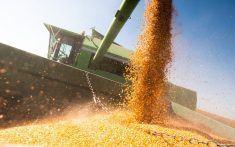MarketsFarm – Analysts are finding the United States Department of Agriculture’s (USDA) 2021-22 monthly crop estimates, which will be released on Aug. 12, to be very hard to predict.
“It seems to me that the range for corn guesses are way, way wider than what we’re getting for new crop beans,” said Sean Lusk, vice-president of Walsh Commercial Hedging Services in Chicago. He added that while corn east of the Mississippi River is looking good, there are trouble spots to the west, causing changes in estimates. The estimated range for corn ending stocks, according to Lusk, is between 1.065 billion to 1.477 billion bushels.
Read Also

U.S. livestock: CME cattle tick lower in thin pre-holiday trade
Chicago | Reuters – Chicago Mercantile Exchange live and feeder cattle futures were little changed but ended slightly lower on…
“It’s a big reason, in my opinion, we’re starting to coil in corn a little bit, meaning the ranges are getting tighter and the markets are starting to develop in a wedge formation,” he said, adding that bids are ranging from US$4.45 to US$5.60 per bushel. “It tells me that you’ve got a big move coming one way or another eventually.”
Lusk also said that corn estimates can also depend on yields in South America and logistical issues hindering corn exports from the continent.
Soybean estimates will be paid close attention by analysts after USDA’s estimates went unchanged last month from June’s report at 155 million bushels.
“The range in estimates is 115 (million) to the down and 236 (million) to the up,” Lusk said. “I don’t know what the USDA’s going to say here, because they can also cut the export estimate and cut beans going into crush and raise ending stocks to 200 million bushels.”
Recently, traders have been buying Kansas City wheat and selling Chicago wheat, according to Lusk, although the latter is trading at a three-cent premium.
“(The Minneapolis) spring wheat contract really rallied against corn, against the two other wheat classes,” he added. Lusk also said reduced wheat yields worldwide, especially in Russia, will affect domestic wheat ending stock estimates.
“Ending stocks look to come in at 644 (million bushels)…The USDA is probably not only going to do an adjustment to the spring wheat numbers, but also the global carryout with Canada leading the way (in reduced yields),” Lusk said. “You’ve got a lot of moving parts for the wheat.”
Terry Reilly, senior commodity analyst for Futures International in Oakbrook Terrace, Ill. predicted 1.307 billion bushels for corn, 155 million for soybeans and 647 million for wheat.
















